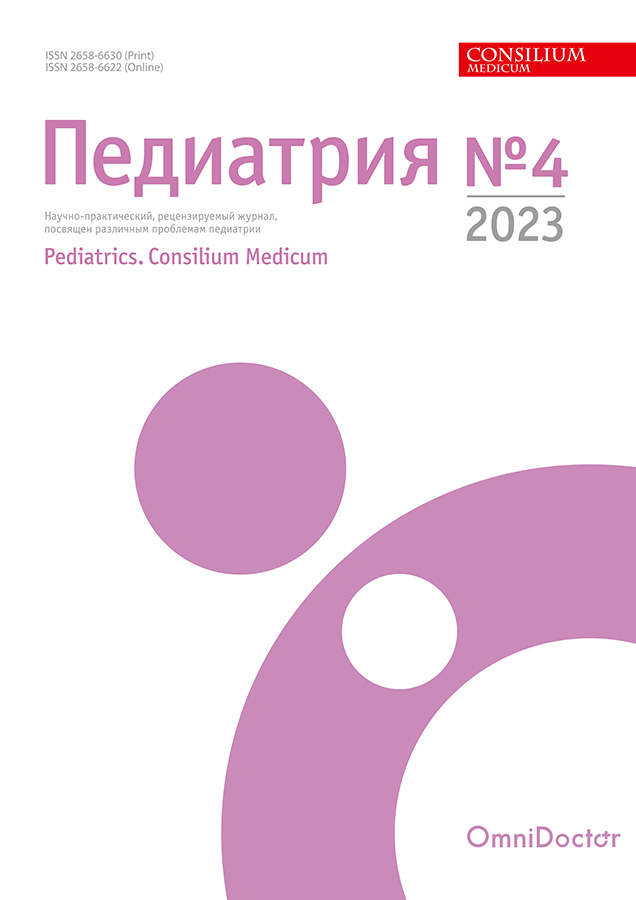Intraluminal removal of hamartoma polyps of the gastrointestinal tract in children
- Authors: Korolev G.A.1, Lokhmatov M.M.1,2, Dyakonova E.Y.1, Tupylenko A.V.1, Oldakovsky V.I.1, Budkina T.N.1, Bekin A.S.1, Yatsyk S.P.1
-
Affiliations:
- National Medical Research Center for Children’s Health
- Sechenov First Moscow State Medical University (Sechenov University)
- Issue: No 4 (2023)
- Pages: 258-261
- Section: Articles
- URL: https://pediatria.orscience.ru/2658-6630/article/view/627398
- DOI: https://doi.org/10.26442/26586630.2023.4.202604
- ID: 627398
Cite item
Full Text
Abstract
Background. Peutz-Jeghers syndrome and juvenile polyposis lead to the formation of hamartoma polyps in the small intestine, which are the cause of anvagination of the small intestine, gastrointestinal bleeding and obstruction of the gastrointestinal tract. Polyps form throughout life and most patients undergo multiple surgeries.
Aim. To determine the effectiveness and safety of balloon enteroscopy (BE) as a method of intraluminal minimally invasive method for removing hamartoma polyps of the deep sections of the small intestine in children with Peutz-Jeghers syndrome and juvenile polyposis.
Materials and methods. The study was performed on the basis of the Endoscopic Research Department of the National Medical Research Center for Children’s Health. In the period from 2013 to 2022, 40 patients were hospitalized: 32 (80%) with Peutz-Jeghers syndrome and 8 (20%) with juvenile polyposis. During the observation period, 78 diagnostic and therapeutic balloon enteroscopies were performed: 70 (89%) antegrade, 8 (11%) retrograde.
Results. A total of 309 polyps of the small intestine were detected during BE: with antegrade BE – 283 (91.5%, mean – 4.1±2.59), with retrograde BE – 27 (8.5%, mean – 3, 48±3.39). A total of 129 polyps of the small intestine were removed: 119 (92.2%) during antegrade BE and 10 (7.8%) during retrograde BE. For BE, detection of clinically significant polyps is predicted with a sensitivity of 90.1% and a specificity of 81.7%. In the postoperative period, 6 complications (7.89%) were revealed. In three cases, a control ultrasound of the abdominal organs revealed small intestinal intussusceptum, so the clinical effect was not achieved: retrograde BE – n=2 (2.62%), antegrade BE – n=1 (1.31%), in two of patients, perforation of the small intestine was detected – retrograde BE – n=1 (1.31%); antegrade BE – n=1 (1.31%) and one patient had bleeding during BE – antegrade BE – n=1 (1.31%).
Conclusion. BE is an effective and safe method of intraluminal minimally invasive removal of small intestinal polyps.
Full Text
About the authors
Grigory A. Korolev
National Medical Research Center for Children’s Health
Author for correspondence.
Email: KorolevG.A@yandex.ru
ORCID iD: 0000-0001-5730-3684
endoscopist
Russian Federation, MoscowMaksim M. Lokhmatov
National Medical Research Center for Children’s Health; Sechenov First Moscow State Medical University (Sechenov University)
Email: lokhmatov@mail.ru
ORCID iD: 0000-0002-8305-7592
D. Sci. (Med.)
Russian Federation, Moscow; MoscowElena Yu. Dyakonova
National Medical Research Center for Children’s Health
Email: Doctor-help03@yandex.ru
ORCID iD: 0000-0002-8563-6002
D. Sci. (Med.)
Russian Federation, MoscowArtem V. Tupylenko
National Medical Research Center for Children’s Health
Email: tupylenko.av@nczd.ru
ORCID iD: 0000-0003-4299-3269
Cand. Sci. (Med.)
Russian Federation, MoscowVladislav I. Oldakovsky
National Medical Research Center for Children’s Health
Email: oldakovskiy@nczd.ru
ORCID iD: 0000-0002-8805-8164
endoscopist
Russian Federation, MoscowTatyana N. Budkina
National Medical Research Center for Children’s Health
Email: tatyana-budkina@mail.ru
ORCID iD: 0000-0002-7379-7298
Cand. Sci. (Med.)
Russian Federation, MoscowAlexander S. Bekin
National Medical Research Center for Children’s Health
Email: bekin@nczd.ru
ORCID iD: 0000-0002-5900-1812
pediatric surgeon
Russian Federation, MoscowSergey P. Yatsyk
National Medical Research Center for Children’s Health
Email: makadamia@yandex.ru
ORCID iD: 0000-0001-6966-1040
D. Sci. (Med.), Prof., Corr. Memb. RAS
Russian Federation, MoscowReferences
- Weaver LT, Austin S, Cole TJ. Small intestinal length: a factor essential for gut adaptation. Gut. 1991;32(11):1321-3. doi: 10.1136/gut.32.11.1321
- Beggs AD, Latchford AR, Vasen HF, et al. Peutz-Jeghers syndrome: a systematic review and recommendations for management. Gut. 2010;59(7):975-86. doi: 10.1136/gut.2009.198499
- Singh AD, Gupta A, Mehta N, et al. Occurrence of gastric cancer in patients with juvenile polyposis syndrome: a systematic review and meta-analysis. Gastrointest Endosc. 2023;97(3):407-14.e1. doi: 10.1016/j.gie.2022.10.026
- Wagner A, Aretz S, Auranen A, et al. The Management of Peutz-Jeghers Syndrome: European Hereditary Tumour Group (EHTG) Guideline. J Clin Med. 2021;10(3):473. doi: 10.3390/jcm10030473
- Kopacova M, Tacheci I, Rejchrt S, Bures J. Peutz-Jeghers syndrome: Diagnostic and therapeutic approach. World J. Gastroenterol. 2009;15(43):5397-408. doi: 10.3748/wjg.15.5397
- Van Lier MGF, Wagner A, Mathus-Vliegen EMH, et al. High Cancer Risk in Peutz-Jeghers Syndrome: A Systematic Review and Surveillance Recommendations. Am J Gastroenterol. 2010;105(6):1258-64. doi: 10.1038/ajg.2009.725
- Latchford AR, Neale K, Phillips RK, Clark SK. Juvenile polyposis syndrome: a study of genotype, phenotype, and long-term outcome. Dis Colon Rectum. 2012;55(10):1038-43. doi: 10.1097/DCR.0b013e31826278b3
- Zhang LJ, Su Z, Liu X, et al. Peutz-Jeghers syndrome with early onset of pre-adolescent gynecomastia: a predigree case report and clinical and molecular genetic analysis. Am J Transl Res. 2017;9(5):2639-44.
- Hinds R, Philp C, Hyer W, Fell JM. Complications of childhood Peutz-Jeghers syndrome: implications for pediatric screening. J Pediatr Gastroenterol Nutr. 2004;39(2):219-20. doi: 10.1097/00005176-200408000-00027
- Yamamoto H, Sugano K. A new method of enteroscopy – the double-balloon method. Can J Gastroenterol. 2003;17(4):273-4. doi: 10.1155/2003/309532
- Li BR, Sun T, Li J, et al. Primary experience of small bowel polypectomy with balloon-assisted enteroscopy in young pediatric Peutz-Jeghers syndrome patients. Eur J Pediatr. 2020;179(4):611-7. doi: 10.1007/s00431-019-03534-1
- Blanco-Velasco G, Hernández-Mondragón OV, Blancas-Valencia JM, et al. Safety and efficacy of small bowel polypectomy using a balloon-assisted enteroscope in pediatric patients with Peutz-Jeghers syndrome. Rev Gastroenterol Mex (Engl Ed). 2018;83(3):234-7 [Article in English, Spanish]. doi: 10.1016/j.rgmx.2017.07.003
- Latchford AR, Neale K, Phillips RK, Clark SK. Peutz-Jeghers syndrome: intriguing suggestion of gastrointestinal cancer prevention from surveillance. Dis Colon Rectum. 2011;54(12):1547-51. doi: 10.1097/DCR.0b013e318233a11f
- Achatz MI, Porter CC, Brugières L, et al. Cancer Screening Recommendations and Clinical Management of Inherited Gastrointestinal Cancer Syndromes in Childhood. Clin Cancer Res. 2017;23(13): e107-14. doi: 10.1158/1078-0432.CCR-17-0790
- Goldstein SA, Hoffenberg EJ. Peutz-Jegher syndrome in childhood: need for updated recommendations? J Pediatr Gastroenterol Nutr. 2013;56(2):191-5. doi: 10.1097/MPG.0b013e318271643c
Supplementary files









